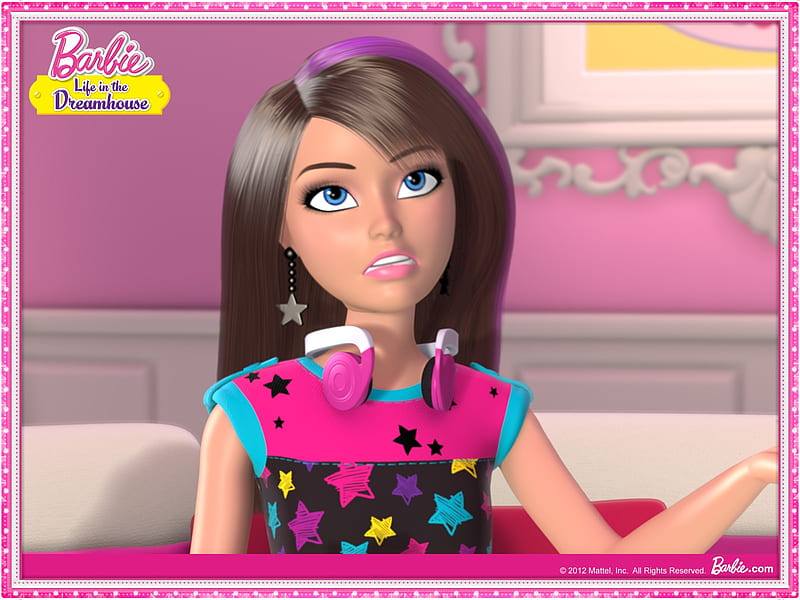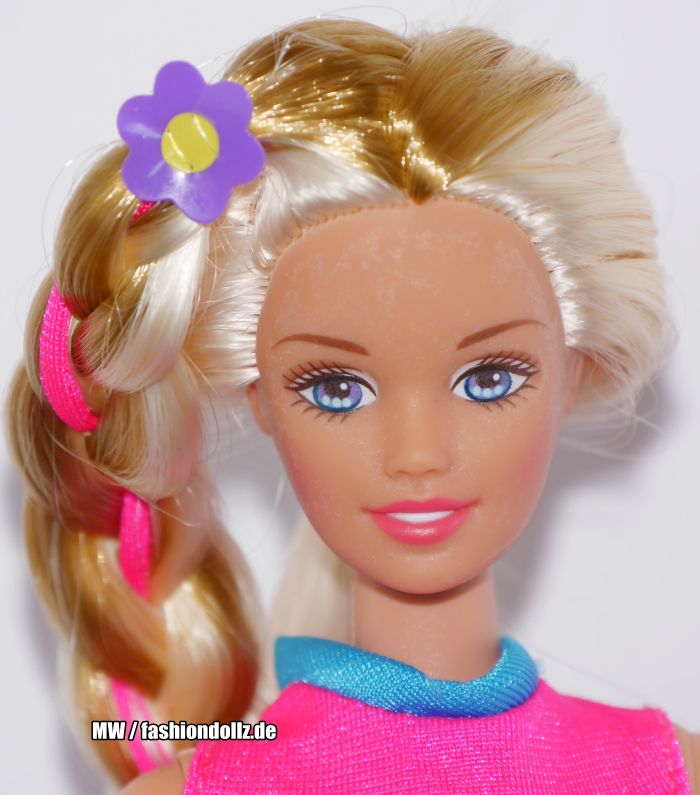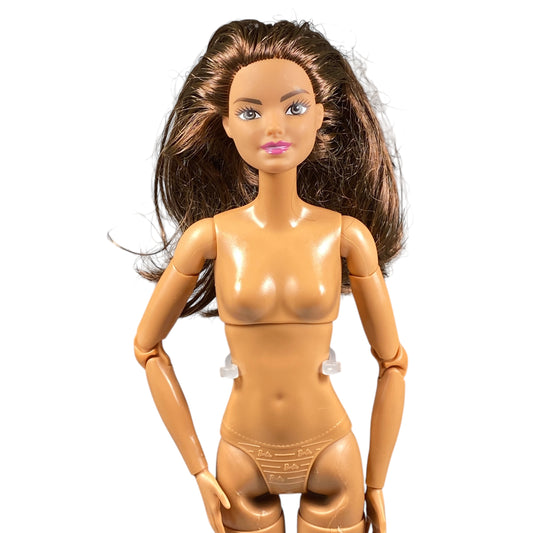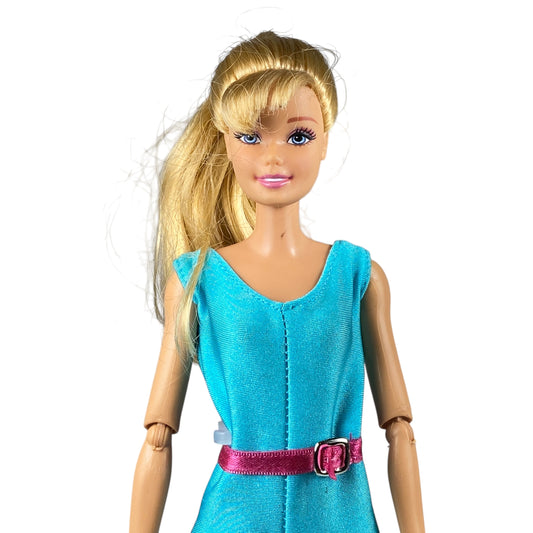The Ultimate Guide to Skipper Barbie: History, Nostalgia, and Collecting
Share

Skipper Roberts, Barbie's beloved little sister, has been a cherished part of the Barbie universe since her introduction in 1964. From her early days as a freckle-faced nine-year-old to her modern incarnation as a tech-savvy teenager, Skipper's evolution mirrors changing perceptions of youth culture across generations. This comprehensive exploration of Skipper Barbie takes you through her fascinating journey, highlighting the most significant doll releases, character developments, and cultural impact that have made her an enduring figure in the world of collectible dolls.

The Birth of Skipper: Barbie's Little Sister Arrives (1964-1965)
The mid-1960s marked a pivotal moment in Mattel's history with the creation of Skipper. Introduced in 1964, Skipper was Mattel's strategic response to a specific market need6. While Barbie had already established herself as a sensation among older girls, many parents hesitated to purchase the mature-looking fashion doll for their younger daughters. Recognizing this gap, Mattel brilliantly conceived Skipper as Barbie's younger sister, offering a more age-appropriate alternative for younger children still wanting to participate in fashion doll play.
The first Skipper doll stood approximately 9 inches tall, noticeably shorter than her older sister Barbie. She featured an endearing childlike appearance with bigger eyes, a rounder face, and a distinctly pre-adolescent figure that parents found more suitable for their younger children6. Mattel positioned her as being around 9 years old, creating the perfect bridge between baby dolls and the more mature Barbie. This thoughtful design choice allowed younger girls to feel they were "growing up" while giving parents comfort that the doll remained appropriately childlike.
When Skipper first appeared on store shelves in 1964, she arrived with an impressive wardrobe of ten outfits that perfectly coordinated with ten of Barbie's most popular ensembles6. This brilliant marketing strategy connected the two dolls while establishing Skipper as a character with her own distinct identity. Through detailed character development in Random House novels, Skipper was established as the second child of George and Margaret Roberts of Willows, Wisconsin, creating a comprehensive backstory that enriched play possibilities.
Expanding the Skipper Universe: The Vintage Years (1966-1970)
Between 1964 and 1970, Skipper underwent several transformations with six distinct versions released during this foundational period1. Among these early iterations were two particularly rare variants that command premium prices among today's collectors: a Reissued Skipper with a distinctively pinker skin tone and the elusive Japanese Skipper, both highly sought after by serious collectors1. Each version featured subtle modifications that reflected Mattel's ongoing refinement of the character and response to market preferences.
By 1966, Skipper had developed her own fashion identity separate from simply mimicking her older sister's style. Her wardrobe evolved to embrace unique designs inspired by contemporary youth fashion trends—from bold op art prints to fashionable bell-bottoms that captured the spirit of the late 1960s5. This transition represented an important milestone as Skipper began establishing herself as a character with her own personality and style preferences rather than merely existing as Barbie's shadow.
The late 1960s introduced a significant innovation with the "Twist 'N Turn" (TNT) Skipper doll in 1968, featuring a more poseable body that allowed for greater play possibilities5. This advancement mirrored similar innovations in the main Barbie line, demonstrating Mattel's commitment to technological improvement across their doll portfolio. The 1970 Sausage Curl TNT Skipper featured distinctive curly hair styling that reflected popular hairstyles of the era, while the 1970 Living Skipper (#1147) featured enhanced articulation for more realistic movement during play.
Skipper's Evolution: The Transitional Years (1971-1974)
The dawn of the 1970s marked a significant shift in Skipper's design aesthetic with the introduction of the Sunset Malibu Skipper in 19711. This release reflected the growing influence of California beach culture on American fashion and leisure activities. With sun-kissed skin, casual beachwear, and relaxed styling, Malibu Skipper embodied the carefree spirit that defined the early 1970s youth experience in America.
The 1972 Malibu Skipper (#1069) further refined this concept, featuring a more casual appearance that resonated with changing fashion sensibilities of the era. During this period, Skipper's wardrobe expanded to include more separates and mix-and-match options, reflecting the increasingly casual approach to fashion that characterized youth culture in the early 1970s. These years represented a transitional period where Skipper began maturing slightly in her appearance while maintaining her distinct position as younger than teenage Barbie.
Accessory lines expanded significantly during this period, with Skipper receiving her own bedroom furniture, playsets, and even a car—despite being canonically too young to drive6. This expansion of Skipper's world created more play possibilities and strengthened her position as a doll that could stand on her own rather than merely complementing Barbie play patterns. The early 1970s solidified Skipper's place in the Barbie universe while setting the stage for more dramatic changes to come.
Growing Up Skipper: Controversy and Innovation (1975-1979)
The mid-1970s brought one of the most controversial chapters in Skipper's history with the introduction of the "Growing Up Skipper" doll in 1975 (#7259)35. This innovative yet contentious doll featured a unique mechanism: when her left arm was rotated, Skipper would literally "grow up"—increasing in height, developing breasts, and widening at the hips to simulate puberty. This dramatic transformation was intended to reflect the physical changes of adolescence, but it provoked significant backlash from parents concerned about the doll's explicit portrayal of puberty.
The controversy surrounding Growing Up Skipper highlighted the delicate balance toy manufacturers faced when addressing developmental themes in children's toys. Despite Mattel's intentions to create an educational doll that normalized bodily changes, many parents felt the execution crossed boundaries of appropriateness for toys marketed to young children. Due to the significant criticism, Mattel eventually removed the doll from stores, though it remains one of the most discussed and collectible Skipper variants among serious Barbie enthusiasts today.
While Growing Up Skipper represented a bold experiment, Mattel continued producing more traditional Skipper dolls throughout the late 1970s. These dolls maintained Skipper's position as a pre-teen or early teenage character while incorporating fashions that reflected the disco era's influence on youth culture. The controversy surrounding the Growing Up variant ultimately influenced Mattel's approach to Skipper's development in subsequent decades, leading to more subtle age progression in the character's evolution.

Skipper in the 1980s: Finding Her Place
The 1980s witnessed Skipper maturing gradually into a more definitively teenage character, reflecting Mattel's recognition that their audience enjoyed dolls that represented slightly older girls. Throughout this decade, Skipper's appearance evolved to incorporate the bold colors, layered fashions, and distinctive hairstyles that characterized 1980s youth fashion. Her wardrobe expanded to include trendy items like leg warmers, oversized shirts, and neon accessories that captured the era's distinctive aesthetic.
During this period, Skipper's world expanded with the introduction of more friends, reflecting the importance of peer relationships in teenage life. These companions helped position Skipper as the center of her own social circle rather than merely existing in relation to Barbie. This strategic expansion of Skipper's universe helped maintain her relevance with children who were increasingly exposed to more diverse entertainment options and toy lines targeting the tween market.
The 1980s also saw greater integration of Skipper into Barbie-themed media, with the character appearing in books, comics, and animated specials. These appearances helped develop Skipper's personality beyond what was possible through doll play alone, establishing her as intelligent, slightly shy, and occasionally struggling with the challenges of being Barbie's younger sister—relatable traits that resonated with many children who had older siblings of their own.
The 1990s Transformation: Teen Skipper Emerges
The 1990s brought a significant reimagining of Skipper as she evolved into a fully teenage character with a distinctly "cool" 90s aesthetic. This transformation reflected Mattel's recognition of changing play patterns and the growing influence of teen culture on younger children. The Teen Skipper of the 1990s featured more mature styling, trendy fashions, and a personality that embraced the decade's emphasis on self-expression and individuality.
Mattel further developed Skipper's character during the early 1990s, placing her at Central Junior High School and exploring themes relevant to adolescent experiences2. This media expansion helped establish Skipper as a character with her own storylines and challenges separate from Barbie's adult world. The comics addressed relatable teenage concerns like school pressure, friendship dynamics, and finding one's identity—themes that resonated with the target audience.
During this era, Skipper's circle of friends expanded significantly to include characters like Courtney, Nikki, and Tori. These diverse companions reflected Mattel's increasing commitment to representation while creating more play possibilities. The 1990s Skipper embodied the decade's girl power ethos with fashion and accessories that emphasized both femininity and independence—a delicate balance that appealed to children and their parents alike.

Millennium Skipper: The 2000s Reinvention
The early 2000s saw another significant evolution in Skipper's design and character development as Mattel repositioned her for a new generation. In 2007, acknowledging the growing popularity of the vintage collector market, Mattel released its second vintage 1964 reproduction Skipper doll wearing her classic "School Days" ensemble2. This release demonstrated the enduring appeal of the original Skipper while introducing her to a new generation of collectors.
The most dramatic transformation came in 2009 when Skipper received a complete redesign featuring a distinctive purple streak in her hair—a visual signifier of her more modern, edgy personality2. This reimagined Skipper was characterized as tech-savvy and clever, reflecting the increasing importance of technology in young people's lives during this period. This strategic repositioning helped maintain Skipper's relevance in an era when traditional dolls faced increasing competition from digital entertainment.
The 2000s Skipper embraced interests like photography, blogging, vlogging, and technology, establishing her as the most digitally oriented member of the Roberts family3. These character traits resonated with children growing up in an increasingly connected world while providing natural storytelling opportunities across Barbie media. Her characterization often included aspirations to become a director or technology inventor, giving her distinct ambitions separate from Barbie's ever-changing career path.

Contemporary Skipper: 2010s to Present
Today's Skipper continues to evolve while maintaining the core elements that have made her beloved for generations. In modern Barbie media like "Barbie Dreamhouse Adventures," Skipper is portrayed as a 14-year-old teenager with a distinctive personality combining technological aptitude, creative interests, and the occasional teenage attitude23. Her character often grapples with relatable adolescent challenges like finding her identity while living in the shadow of her famous older sister—a storytelling element that adds depth to the character.
The 2023 television film "Barbie: Skipper and the Big Babysitting Adventure" gave Skipper a starring role, demonstrating her ongoing importance in the Barbie media universe2. This feature highlighted Skipper's independence and problem-solving abilities while introducing her to yet another generation of children. Contemporary Skipper dolls maintain her teenage appearance while incorporating fashion trends relevant to today's youth, ensuring the character remains relatable to current consumers.
Modern Skipper dolls feature significant articulation, diverse fashion options, and accessories that reflect contemporary teenage interests. Her image has been carefully balanced to appear mature enough to appeal to older children while remaining appropriate for the broader Barbie audience. This delicate positioning allows Skipper to serve as both an aspirational figure for younger children and a relatable character for those approaching their teenage years.
Collecting Vintage Skipper: A Guide for Enthusiasts
For collectors, Skipper dolls represent a fascinating subset of Barbie collecting with unique challenges and rewards. The earliest Skipper dolls from 1964-1970 are particularly prized, with the original Skipper in her iconic red two-piece swimming suit being among the most sought-after. Rare variants like the Japanese Skipper and the pink-toned reissue command premium prices when found in good condition with original outfits and accessories intact.
Condition plays a crucial role in determining the value of vintage Skipper dolls. Common issues include fading of the original hair color, face paint wear, and limb loosening—problems that can significantly impact collectible value. Many enthusiasts seek dolls that retain their original rooted eyelashes, clear complexion, and vibrant hair color. Original packaging dramatically increases value, with boxed examples in mint condition representing the pinnacle of Skipper collecting.
The controversial Growing Up Skipper from 1975 has become one of the most valuable Skipper variants due to its historical significance and relative scarcity resulting from its short production run. Other highly collectible Skippers include limited editions, international variants, and dolls with rare hair colors or styling. For beginning collectors, the reproductions released in the 2000s offer an accessible entry point while authentic vintage pieces can be sourced through specialized doll dealers, online marketplaces, and collector conventions.
Skipper's Cultural Impact and Legacy
Throughout her nearly six-decade history, Skipper has played an important role in the Barbie universe while making her own distinct cultural contributions. As one of the first dolls specifically designed to represent a pre-teen/young teenage girl, Skipper helped establish a market for dolls that bridged the gap between baby dolls and adult fashion dolls56. This innovation recognized the unique developmental stage of tweens and early teens, acknowledging their specific interests and concerns.
Skipper's evolution reflects changing cultural perceptions of girlhood and adolescence across generations. From her innocent beginnings as a freckle-faced nine-year-old to her contemporary incarnation as a tech-savvy teenager, Skipper's transformations mirror society's evolving understanding of young womanhood. These changes document shifts in how toy manufacturers have approached representing growing up—from the explicit approach of Growing Up Skipper to the more nuanced characterization found in contemporary media.
For many collectors and enthusiasts, Skipper dolls evoke powerful nostalgia for their own childhoods and adolescent experiences. The distinctive fashions, accessories, and styling of each era's Skipper variant serve as time capsules of youth culture across decades. This emotional connection explains why Skipper continues to inspire passionate collecting and why Mattel regularly revisits the character through reissues, commemorative editions, and new media appearances.
The Future of Skipper Barbie
As Skipper approaches her 60th anniversary, her future looks bright with continuing relevance in both the doll market and Barbie media universe. Mattel's ongoing investment in Skipper-centered content like "Barbie: Skipper and the Big Babysitting Adventure" suggests confidence in the character's enduring appeal to new generations of children. The successful balance of maintaining Skipper's core identity while updating her to reflect contemporary youth culture has proven a winning formula that will likely continue.
Technological advancements in doll manufacturing offer exciting possibilities for future Skipper releases, with potential innovations in articulation, interactive features, and customization options. As today's digitally native children embrace play patterns that blend physical toys with digital content, Skipper's established tech-savvy personality positions her perfectly to bridge these worlds through augmented reality experiences, companion apps, and interactive storytelling.
For collectors, Skipper's anniversary milestones will likely bring special edition releases that celebrate her history while introducing new collectors to the joy of Skipper collecting. Whether through faithful reproductions of classic dolls or innovative new designs that push the character forward, Skipper's future promises to honor her rich heritage while continuing to evolve with changing times—just as she has done successfully for nearly six decades.
Conclusion: Why Skipper Endures
From her introduction as Barbie's little sister in 1964 to her current status as a beloved character in her own right, Skipper Barbie has demonstrated remarkable staying power in the competitive world of toys. Her endurance can be attributed to Mattel's willingness to evolve the character while maintaining the core elements that make her recognizable and beloved. Through careful transitions from child to pre-teen to teenager, Skipper has remained relevant to each new generation while accumulating a rich history that appeals to collectors.
Skipper's continuing appeal lies in her relatability. As the younger sister to the impossibly perfect Barbie, Skipper often represents the more accessible, imperfect experience of growing up. Her struggles with finding her identity, dealing with the shadow of a successful older sibling, and navigating the challenges of adolescence resonate with many children's lived experiences. This authenticity, even within the fantastical Barbie universe, creates a character with genuine emotional appeal.
Whether you're a serious collector seeking rare vintage Skipper variants, a nostalgic adult reconnecting with childhood memories, or introducing a young person to the joy of Barbie dolls, Skipper offers something special. Her six-decade journey from freckle-faced little sister to independent teenager documents not just the evolution of a beloved toy but the changing perception of girlhood itself—a remarkable legacy for what began as a strategic extension of the Barbie brand. In Skipper, Mattel created not just a doll but a cultural touchstone that continues to inspire creativity, collectability, and cherished play experiences across generations.




